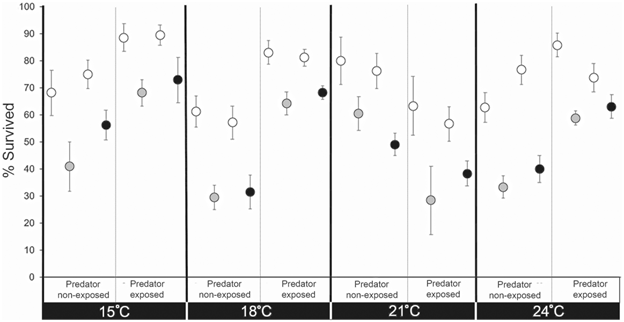In a recent study by Ward et al. (2020), Heiko Schoenfuss, Jessica Ward, and their colleagues present the experimental results on the effects of an endocrine disrupting chemical that is known to escape from wastewater into the natural aquatic environment on ecological interactions of fish species.
Over 20 years, Heiko Schoenfuss, as director of Aquatic Toxicology Laboratory at St. Cloud State University, Minnesota, has been investigating a variety of environmental endocrine disrupting chemicals (EDCs) that are known to interfere with normal actions of hormones and their adverse effects on many aspects of organisms, which are exposed to such environmental pollutants. More specifically, using common fish species such as fathead minnow (Pimephales pomelas) as a model system, he and his colleagues pursue to advance the understanding of endocrine disruption in reproduction and development in fish.

The most well-known and publicized effects of these EDCs are on reproductive function and behavior in humans such as certain EDCs altering normal development of reproductive organs or causing endocrine-related cancers. However, the EDCs are known to cause numerous aversive effects on aquatic organisms such as fish, amphibians, and reptiles (e.g., Guillette et al., 2001), and these effects include disrupted sex differentiation (e.g., feminized or masculinized sex organs) and altered sexual behavior. In addition, Ward et al. (2020) cites studies that demonstrated reduced courtship behavior and aggression in male fishes exposed to environmental estrogens and altered mate choice in female fishes. There are a few studies that examined the effects of EDCs on single fish species including his team’s previous studies (McGee et al., 2009; Ward et al., 2017), and the recent study (Ward et al., 2020) examines how EDCs, particularly a form of estrogen (Estrone, E1) commonly excreted female hormone into waterways and widely found in the natural aquatic environment influences ecological interaction between the exposed predator and prey fish.
Lab Experiments – Exposure & Predation Trials
In the recent study, Ward et al. (2020) raised adult bluegill sunfish (Lepomis macrochirus) and larval fathead minnow (Pimephales pomelas) and exposed them to a low concentration (90 ng/L) and high concentration (414 ng/L) of Estrone (E1) for a month at four different temperatures, the range of which simulated the seasonal fluctuation of the ambient temperature. After this exposure period, the starved predator (for 3 days) and the prey were placed in the same enclosure for one hour. At the end of the predation trial, survived exposed and control minnows were sorted, and the prey capture/consumption rates from 16 tested scenarios with temperature (a total of 219 adult sunfish and 2,096 larval fathead minnow) were evaluated.

Figure 2. Percent survival of larval fathead minnows in competitive predation trials. Larvae were exposed to either a low (E1low; gray symbols) or high (E1high; black symbols) dose of E1 for 30 days or to an equivalent volumetric percentage of solvent (control; white symbols) at one of four temperatures (15°C, 18°C, 21°C, and 24°C). Points and whiskers are mean±SEM (Ward et al., 2020).

Findings
From their analysis of variance, Ward et al. (2020) saw that the prey capture/consumption rate by the E1 exposed predatory sunfish (with both low and high E1 concentrations) decreased significantly (by approx. 15%) compared with non-exposed sunfish (Figure 1 and 2). In addition to this observation, different temperatures had variable influence on this outcome, indicating the severity of endocrine disruption by E1 perhaps may be temperature dependent. Ward et al. (2020) also noted that the E1 exposed prey fathead minnow did have higher probability (22-25% higher) of getting captured and eaten. As demonstrated by Schoenfuss and his colleagues in this recent study, and also consistent with similar studies with other fish species exposed to a various endocrine disruptive contaminants, dynamics of species interactions between predators and prey can be altered (disrupted). Because there are many possible mechanisms to be impacted and thus causing this disruption such as neural physiology involved in prey detection and predatory maneuver, Ward et al. (2020) calls for more studies to elucidate the very mechanism that leads to the effect that they saw with both predators and prey exposed to EDCs like E1 investigated in this study. They also raise the importance of thermal sensitivity of animals because their performance in prey capture or locomotion (e.g., predator evasion) can be influenced by not only temperature alone but also interaction of contaminants with temperature.
As this recent study of Ward et al. (2020) provides data on dosage and thermal influence on the effect of E1 on interactions between predator and prey fishes, we are able to further hypothesize what EDCs would do to not only individual fish that are vulnerable to such exposure but also how one animal interacts with the other as an ecological community.
Dr. Takashi Maie is an Assistant Professor of Biology at University of Lynchburg. His research interests include functional morphology and biomechanics of vertebrate animals. He especially loves to work with the most amazing group of vertebrates, fish! You can contact with via email: maie.t@lynchburg.edu.